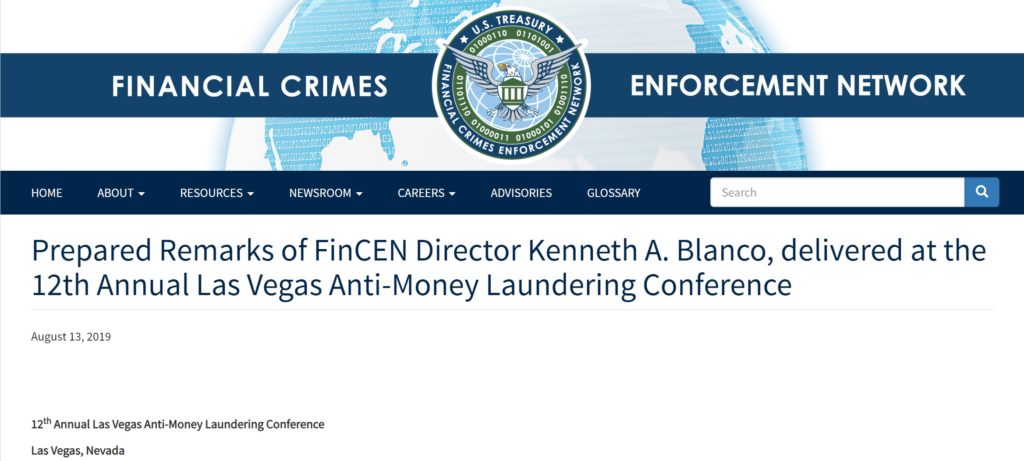Two Million SARs are Filed Every Year … But Which Ones Provide Tactical or Strategic Value to Law Enforcement?
On August 13, 2019, FinCEN Director Kenneth A. Blanco delivered prepared remarks at the 12th annual Law Vegas AML Conference for casinos and card clubs. The remarks are available at Director Blanco Remarks 8-13-2019
Included in the Director’s remarks was some interesting information on an eight-month old “BSA Value Project” that may have been started because, as Director Blanco remarked, FinCEN has “heard during our discussions that there continues to be a desire for more feedback on what FinCEN is seeing in the BSA data in terms of trends [and] we need to do better SAR analysis for wider trends and typologies …”. Director Blanco noted that “We want to provide more feedback, and we will.”
There has not been much public mention of the BSA Value Project: a quick Google search shows that FinCEN’s Associate Director Andrea Sharrin introduced the BSA Value Project at a Florida International Bankers Association (FIBA) conference on March 12, 2019, and then Director Blanco described it in his August 13th remarks:
In January 2019, FinCEN began an ambitious project to catalogue the value of BSA reporting across the entire value chain of its creation and use. The project will result in a comprehensive and quantitative understanding of the broad value of BSA reporting and other BSA information to all types of consumers of that information.
We already know that BSA data plays a critical role in keeping our country strong, our financial system secure, and our families safe from harm. But FinCEN is using the BSA Value Project to improve how we communicate the way BSA information is valued and used, and to develop metrics to track and measure the value of its use on an ongoing basis. The project has included hundreds of interviews with stakeholder groups, including casinos.
So far, the study has confirmed there are extensive and extremely varied uses of BSA information across all stakeholders (including by the private sector) consistent with their missions.
Almost One in Four FBI and IRS-CI Investigations Use BSA Data
Director Blanco made the following remarks on the usefulness of BSA data:
All FBI subject names are run against the BSA database. More than 21 percent of FBI investigations use BSA data, and for some types of crime, like organized crime, nearly 60 percent of FBI investigations use BSA data. Roughly 20 percent of FBI international terrorism cases utilize BSA data.
The Internal Revenue Service-Criminal Investigation section alone conducts more than 126,000 BSA database inquiries each year. And as much as 24 percent of its investigations involving criminal tax, money laundering, and other BSA violations are directly initiated by, or associated with, a BSA report.
In addition to providing controlled access to the data to law enforcement, FinCEN also proactively pushes certain information to them on critical topics. On a daily basis, FinCEN takes the suspicious activity reports and we run them through several categories of business rules or algorithms to identify reports that merit further review by our analysts.
Our terrorist financing-related business rules alone generate over 1,000 matches each month for review and further dissemination to our law enforcement and regulatory partners in what we call a Flash report. These Flash reports enable the FBI, for example, to identify, track, and disrupt the activities of potential terrorist actors. It is incredibly valuable information.
But Which BSA Filings are Providing Real Value to Law Enforcement?
There is no doubt that the (roughly) 20 million BSA reports that are filed each year provide great value to law enforcement. But questions remain about the utility of those filings, and the costs of preparing them. Some of those questions include: (i) which of those reports provide value? (ii) what kind of value is being provided – tactical and/or strategic? (iii) can financial institutions eliminate the “no value” filings and deploy those resources to higher-value filings? (iv) can financial institutions automate the preparation and filing of the low value filings and deploy those resources to the highest-value filings?
I have written a number of articles on the need for better reporting on the utility of SAR filings. Links to three of them are:
SAR Feedback 314(d) – July 30 2019
BSA Reports and Federal Criminal Cases – June 5 2019
The TSV SAR Feedback Loop – June 4 2019
Conclusion
Kudos to Director Blanco and his FinCEN team for their initiative and efforts around the BSA Value Project. The results of the Project could be a game-changer for the financial industry’s BSA/AML programs. The industry is being inundated with calls to apply machine learning and artificial intelligence to make their AML programs more effective and efficient. But if those institutions don’t know which of their filings provide value, and arguably only one in four is providing value, they cannot effectively use machine learning or AI.
The entire industry is looking forward to the results of FinCEN’s BSA Value Project!

